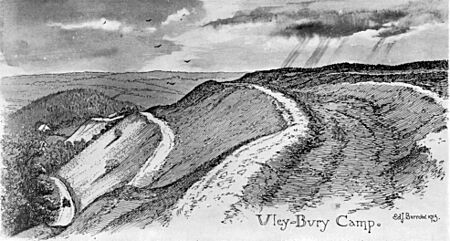Uley Bury facts for kids
Uley Bury is a long, flat-topped hill in Gloucestershire, England, near the village of Uley. It's famous for being an amazing Iron Age hill fort. This means it was once a large, protected settlement built on top of a hill by people living around 300 BC. The hill is about 750 feet (235 metres) high, giving it fantastic views over the Severn Valley.
Contents
What is Uley Bury Made Of?
Uley Bury is part of the Cotswolds hills. It's mostly made of thick layers of a rock called limestone. This limestone formed during the Jurassic period, which was millions of years ago! Underneath the limestone, there are layers of sand.
Part of Uley Bury is a special protected area called a Site of Special Scientific Interest (SSSI). This is because it has lots of amazing fossils from the Lower Jurassic period. You can find many ancient sea creatures here, especially a type of fossil called ammonites. These fossils help scientists understand what the Earth was like long, long ago.
Ancient History of Uley Bury
Uley Bury was a very large settlement during the Iron Age. People lived here from about 300 BC to 100 AD. The fort covers a huge area, about 32 acres (13 hectares)! It's one of many hill forts you can see along the Cotswold hills, like Crickley Hill and Painswick Beacon.
The hill fort was naturally protected by steep slopes on almost all sides. To make it even safer, the people built two lines of huge earth walls, called ramparts, around the edges. These ramparts are more than a mile long in total!
Archaeologists (people who study ancient times) dug into the ramparts in the 1970s. They found out how these big walls were built. They also found many interesting things, like:
- A burial of a person.
- Iron bars that were used as money.
- Stones for grinding grain.
- A decorative pin called a brooch.
- Lots of pottery pieces.
Other finds over the years include a gold coin from an ancient British tribe called the Dobunni, and a silver coin from the Roman Empire.
Pictures taken from the air show marks on the ground that suggest there were once many houses inside the hill fort. However, these areas haven't been dug up by archaeologists yet.
Uley Bury is a Scheduled Ancient Monument. This means it's a very important historical site that is protected by law. Nearby, you can also find Hetty Pegler's Tump, which is an ancient burial mound, and West Hill, where a Roman-British temple once stood.
Nature and Wildlife
Uley Bury is a really important place for wildlife. It has a special type of grass called "unimproved limestone grassland." This grass has been growing here for hundreds of years because animals have grazed on it.
The Bury is part of the Cotswold Area of Outstanding Natural Beauty (AONB). This area has a lot of this special grassland, more than half of all of it in the UK! To help protect this important habitat, a program of regular summer grazing was started in 2004. This helps keep the grass healthy for all the plants and animals that live there.
How to Find Uley Bury
Uley Bury is located at 51°41.3′N 2°18.7′W / 51.6883°N 2.3117°W.
The easiest way to get there is from the B4066 road at Crawley Hill, just north of Uley. You can also reach it by walking along the Cotswold Way or other local footpaths and bridleways.


